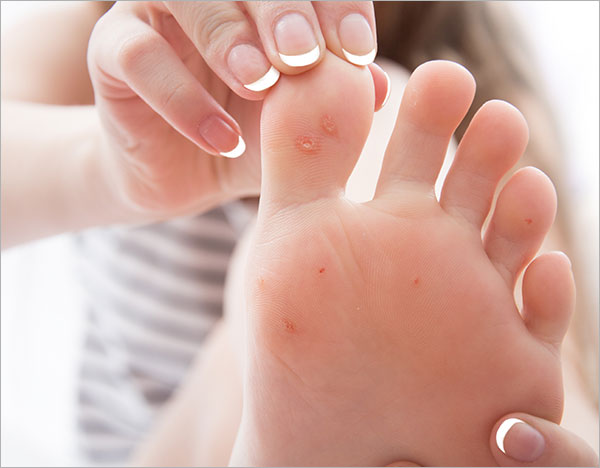Understanding Corns and Warts: Causes, Symptoms, and Effective Treatments

Corns and warts are common skin issues that can be uncomfortable and sometimes painful. Though they may seem similar, corns and warts have different causes and characteristics. Knowing the difference between the two is essential to seek the right corns and warts treatment and alleviate discomfort effectively.
In this blog, we’ll cover the causes, symptoms, and a range of treatment options available for corns and warts, helping you make informed decisions about your care.
What Are Corns and Warts?
Understanding what corns and warts are is the first step toward effective treatment.
Corns
Corns are hardened layers of skin that develop due to friction or pressure, often found on the toes or other bony areas of the feet. They are more common among individuals who wear ill-fitting shoes, have bony feet, or engage in activities that put pressure on their feet. Corns can be uncomfortable and may even cause pain if left untreated.
Warts
Warts are small growths on the skin caused by the human papillomavirus (HPV). They can appear on various parts of the body, including the hands, feet, and face. Warts can spread through contact and are more common in individuals with weakened immune systems or those exposed to the virus in warm, moist environments.
Key Differences Between Corns and Warts
Although they may appear similar, corns and warts differ in cause and appearance:
- Corns are generally smooth and round with a hard or soft center, depending on their location. They are typically surrounded by inflamed skin.
- Warts are usually rough and grainy, with tiny black dots (caused by clotted blood vessels) on the surface. They may feel bumpy and can spread to other areas.
By understanding the differences between these conditions, you can take steps toward the most effective corns and warts treatment.
Causes of Corns and Warts
Causes of Corns
- Pressure and Friction: Repeated friction, often due to ill-fitting footwear or certain activities, causes corns to develop as the skin tries to protect itself.
- Abnormal Foot Shape: Conditions like bunions, hammertoes, or flat feet can increase the likelihood of corn formation.
Causes of Warts
- HPV Infection: Warts are caused by various strains of HPV, with plantar warts forming on the feet due to exposure in damp environments like pools or locker rooms.
- Immune System Vulnerability: People with weakened immune systems may be more susceptible to warts, as their bodies may struggle to fight off the HPV virus.
Symptoms of Corns and Warts
Both corns and warts have unique symptoms that can help identify them correctly.
Symptoms of Corns:
- Hardened skin, usually on the toes, sides, or soles of the feet
- Pain when pressure is applied
- A defined shape, often round and smooth
Symptoms of Warts:
- Rough, raised bumps with tiny black dots
- Itching or mild discomfort
- Occasional pain, especially with plantar warts on the feet
If you experience any of these symptoms, seeking corns and warts treatment can help relieve discomfort and prevent complications.
Effective Treatment Options for Corns and Warts
Treatments for corns and warts vary based on severity, location, and individual health conditions. Here are some common methods:
1. Over-the-Counter Remedies
OTC remedies are often the first choice for mild cases and are readily available.
- For Corns: Non-medicated pads, foam cushions, and salicylic acid can help reduce corn size and alleviate pain.
- For Warts: OTC wart removers containing salicylic acid can be effective when used regularly.
2. Medical Procedures
When OTC options aren’t enough, medical procedures offer effective solutions.
- Cryotherapy: A common treatment for warts, cryotherapy involves freezing the wart with liquid nitrogen, causing it to fall off gradually.
- Trimming or Shaving: A healthcare provider can trim thick corns to relieve pressure.
3. Prescription Treatments
For persistent cases, a doctor may prescribe stronger medications.
- Imiquimod Cream: For warts, this cream stimulates the immune system to combat HPV, gradually reducing the wart’s size.
- Keratolytic Agents: Prescription-strength creams for corns help soften hardened skin, making it easier to remove.
4. Surgical Options
If other methods fail, surgical removal may be necessary.
- Laser Therapy: Laser treatment can target and destroy wart tissue, typically used for stubborn warts.
- Surgical Excision: For large, painful corns, a doctor may surgically remove the corn to alleviate discomfort.
Preventing Corns and Warts
Prevention is the best approach to avoid the pain and inconvenience of corns and warts.
- Choose Proper Footwear: Opt for shoes that fit well and provide ample cushioning to reduce pressure on your feet.
- Practice Good Hygiene: Keep your feet clean and dry, especially in public areas like pools or gyms.
- Avoid Direct Contact with Warts: Refrain from touching or picking at warts, as this can lead to spreading.
FAQs on Corns and Warts Treatment
- Can corns and warts go away on their own?
While warts may resolve without treatment in some cases, corns generally require intervention due to the ongoing friction and pressure that caused them. - How long does it take for treatments to work?
Over-the-counter treatments may take weeks to show results, while medical procedures often yield faster outcomes. - Is there a risk of warts spreading?
Yes, warts are contagious. Avoid picking at them and practice hygiene to prevent spreading the virus. - Are there any side effects from treatment?
Side effects vary by treatment type but may include redness, swelling, or minor pain at the treatment site. Consult your doctor if side effects persist. - When should I seek medical help?
If corns or warts are painful, persistent, or interfere with daily activities, consult a healthcare provider for specialized corns and warts treatment.
Conclusion
Corns and warts, though common, can be uncomfortable and affect quality of life if untreated. Understanding the differences between the two and exploring various corns and warts treatment options can help you find relief and prevent recurrence. By following preventive measures and consulting with a healthcare professional, you can take control of your skin health and enjoy a pain-free lifestyle.
Read More
Discovering the Benefits of Working with a Physical Therapist in Mesa AZ









